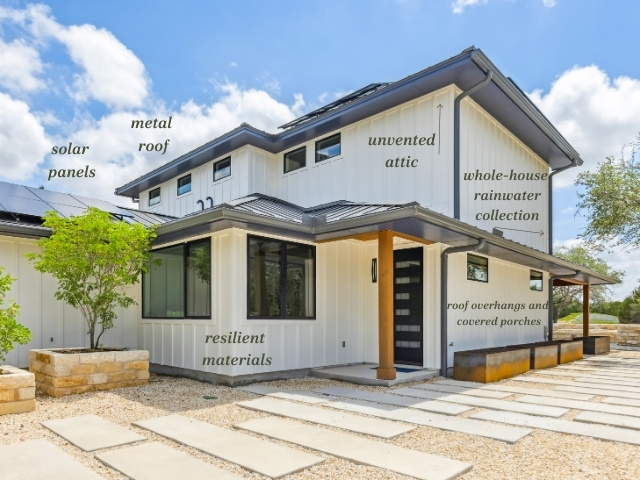Beauty and function matter when it comes to building a home, but so does place. Every home sits within a climate, a landscape, and a set of conditions that shape how it performs. For Austin, TX and the surrounding areas, building for place means more than adapting for a hot, humid climate. It means applying building science principles and resilient design strategies specific to our region so that homes remain healthy, durable, and efficient for generations to come. The following is an overview of our Build Native building standard.
Building Science as the Foundation
Central Texas has long, hot summers and relatively high humidity that put unique demands on a home. Without a thoughtful building envelope, moisture can creep in, materials can fail early, and energy bills can climb. Building science provides the roadmap for avoiding those pitfalls. By focusing on air control, moisture management, and thermal performance, we create homes that are optimized for their location.

Resilient Materials for the Building Envelope
Durability starts on the outside. Resilient cladding, high-performance windows, and roofing systems designed for both intense sun and heavy rains form the first line of defense. Choosing materials that stand up to Austin’s weather means less maintenance, longer lifespans, and fewer repairs down the road.
Unvented Attics for Comfort and Performance
By bringing the attic into the conditioned space, spray foam insulation and metal roof allow ducts and mechanical systems to operate more efficiently, while the home stays cooler and healthier. Unvented attics also contribute to the home’s resilience to wind and fire. It’s one of those behind-the-walls details that homeowners rarely see but feel every day.
Roof Overhangs as Passive Design
Sometimes resilience is as simple as good shading. Roof overhangs reduce solar heat gain, shield windows from intense sun, and protect siding from driving rain. Covered porches allow for outdoor living even in the summers. Roof overhangs and passive design are a reminder that building for place isn’t only about technology, it’s also about timeless strategies that work with nature.
Solar Panels for Energy Independence
The Texas sun can be intense, and a powerful resource. Solar panels are a natural fit for Central Texas homes, helping offset cooling demands. Paired with battery storage, solar provides resilience during grid outages, ensuring that essential systems keep running. More than just lowering utility bills, solar is a way of living in a home that aligns with the rhythm of its place. Solar can turn the challenge of the sun’s heat into an opportunity for clean, renewable energy and good investment.
Whole-House, Potable Rain Water Collection
Many people don’t know rainwater harvesting is a viable source of reliable water supply. However, with the area’s 34 inches of annual rainfall, a 30,000-gallon rainwater harvesting tank can provide enough water for a family of four’s daily household needs. Additionally, rainwater does not contain hard minerals that often lead to plumbing problems.
Building Homes that Belong
At the end of the day, building for place is about stewardship of the land, resources, and the families who call these houses home. Find out more about Build Native’s green building practices here.